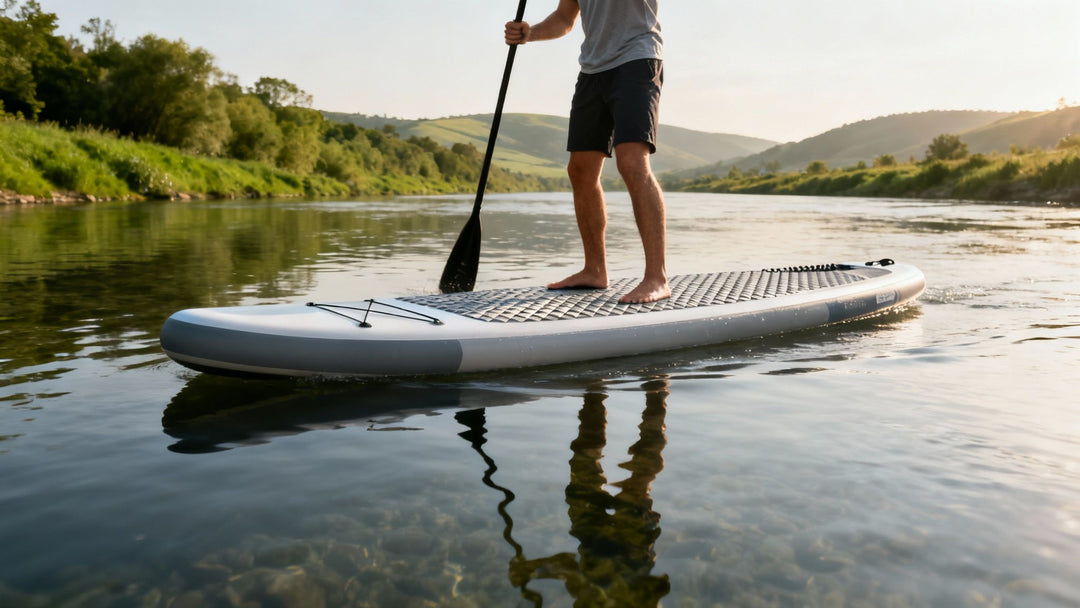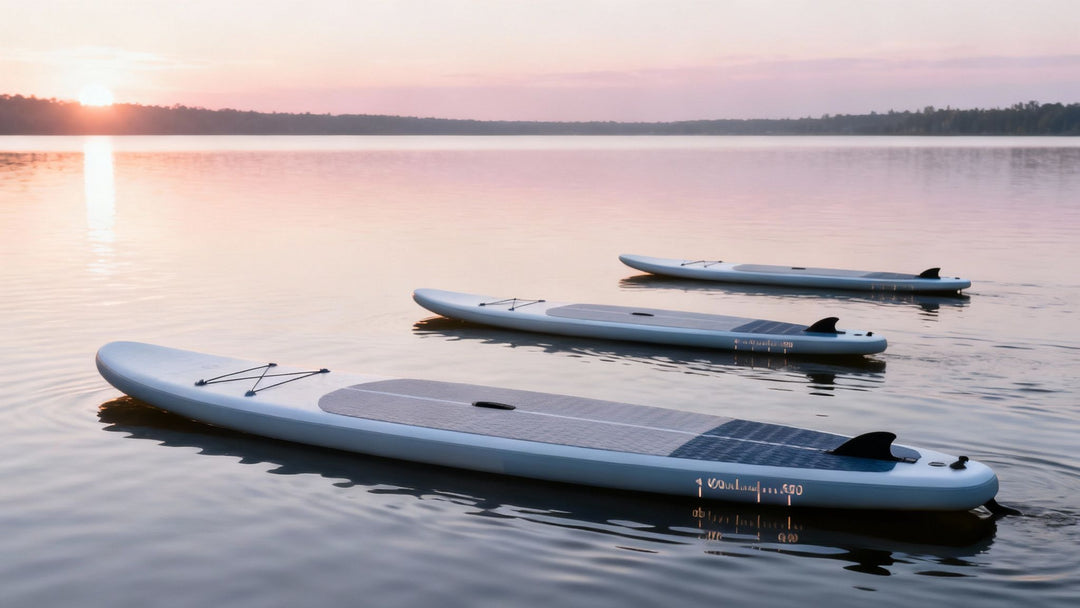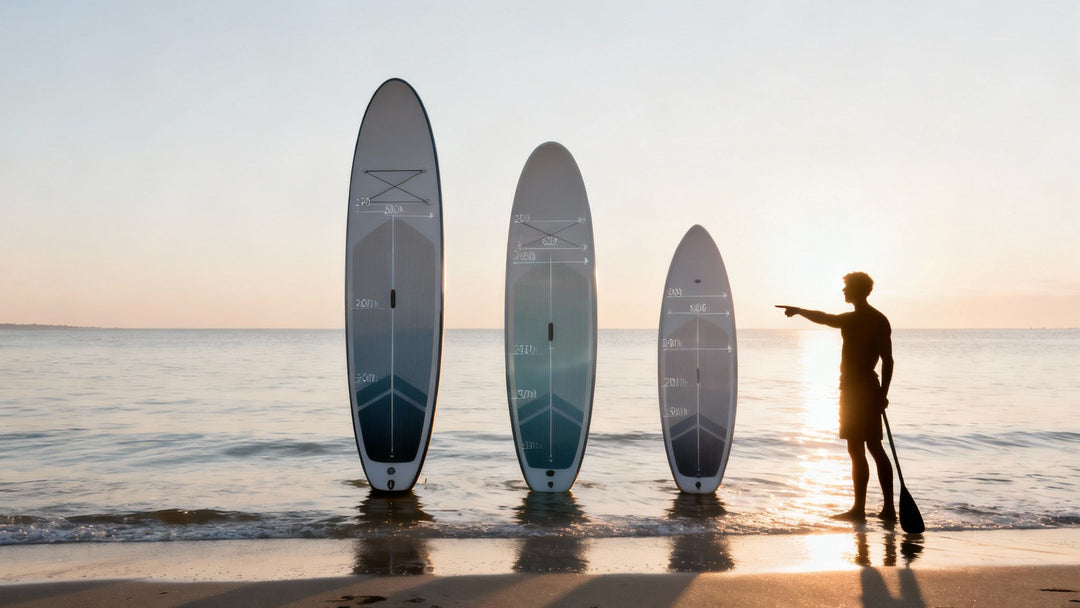Your Ultimate Paddle Board Size Guide
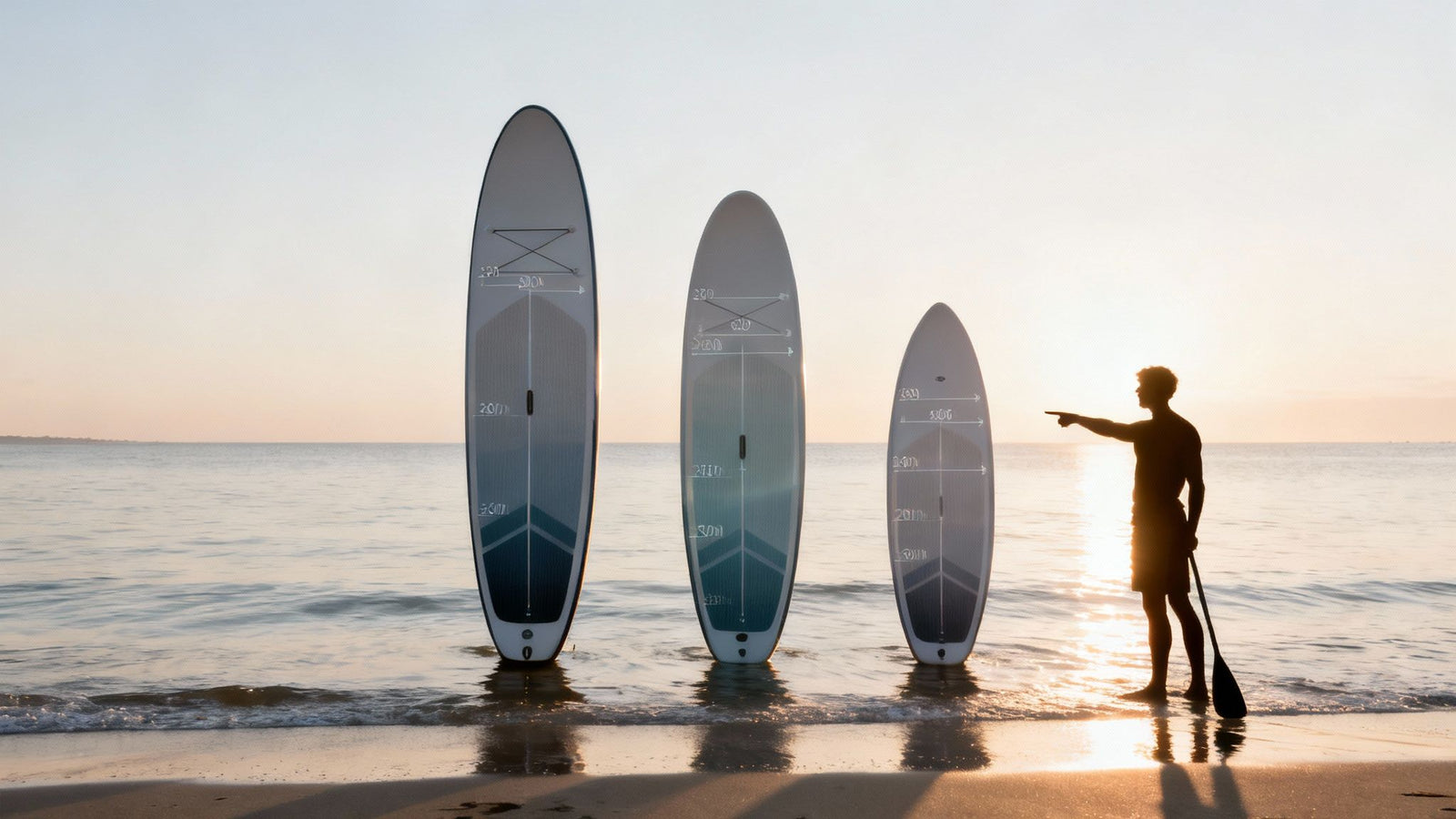
Choosing the right stand up paddle board is a big deal, and this guide is here to make it simple. Honestly, finding your perfect board size really just comes down to three things: your body weight, your skill level, and what you plan to do with it, or your paddling purpose.
Think of it this way: a longer board gives you more speed, a wider one keeps you stable, and the board's overall volume makes sure it can actually support you on the water.
Finding Your Perfect Board Size Fast
Picking out your first paddle board can feel a bit overwhelming with all the numbers and specs. But it really just boils down to matching the board's dimensions to you and your adventures. It's a lot like buying a good pair of walking boots; you need the right fit for the type of terrain you'll be exploring.
If you get a board that's too small for you, it's going to feel wobbly and unstable, which isn't much fun. On the flip side, a board that's way too big will feel sluggish and be a real pain to turn.
The aim is to find that sweet spot. The right board feels like a natural extension of you out on the water. Whether you're planning chilled-out paddles on a local canal or tackling some choppy coastal waves, getting the size right from the start is what makes all the difference. You'll spend your time actually enjoying the paddle, not just trying to stay balanced.
The Core Sizing Factors
To find your perfect match, you need to connect the dots between your own stats, your paddling goals, and the board's specifications. While the details can get complex, understanding the basic principles of a comprehensive size guide is a great starting point for matching dimensions to your needs. For paddle boards, it always comes back to these three key elements.
- Your Body Weight: This is the most important factor. It directly impacts the volume your board needs to have to keep you afloat and stable. For example, a 95kg rider will need a board with significantly more volume than a 65kg rider to feel secure. Simple as that.
- Your Skill Level: If you're just starting out, a wider, more stable board like a Loco Amigo will be your best friend. More experienced paddlers might go for something narrower to get better performance and speed, like a sleek touring board.
- Your Paddling Purpose: What are you going to do with the board? This mainly decides the board's length. Long, sleek boards are brilliant for touring and covering distance, while shorter, more nimble boards are what you want for playing in the surf.
This infographic breaks down how these three pillars—your weight, skill, and paddling style—form the foundation for picking the right board.
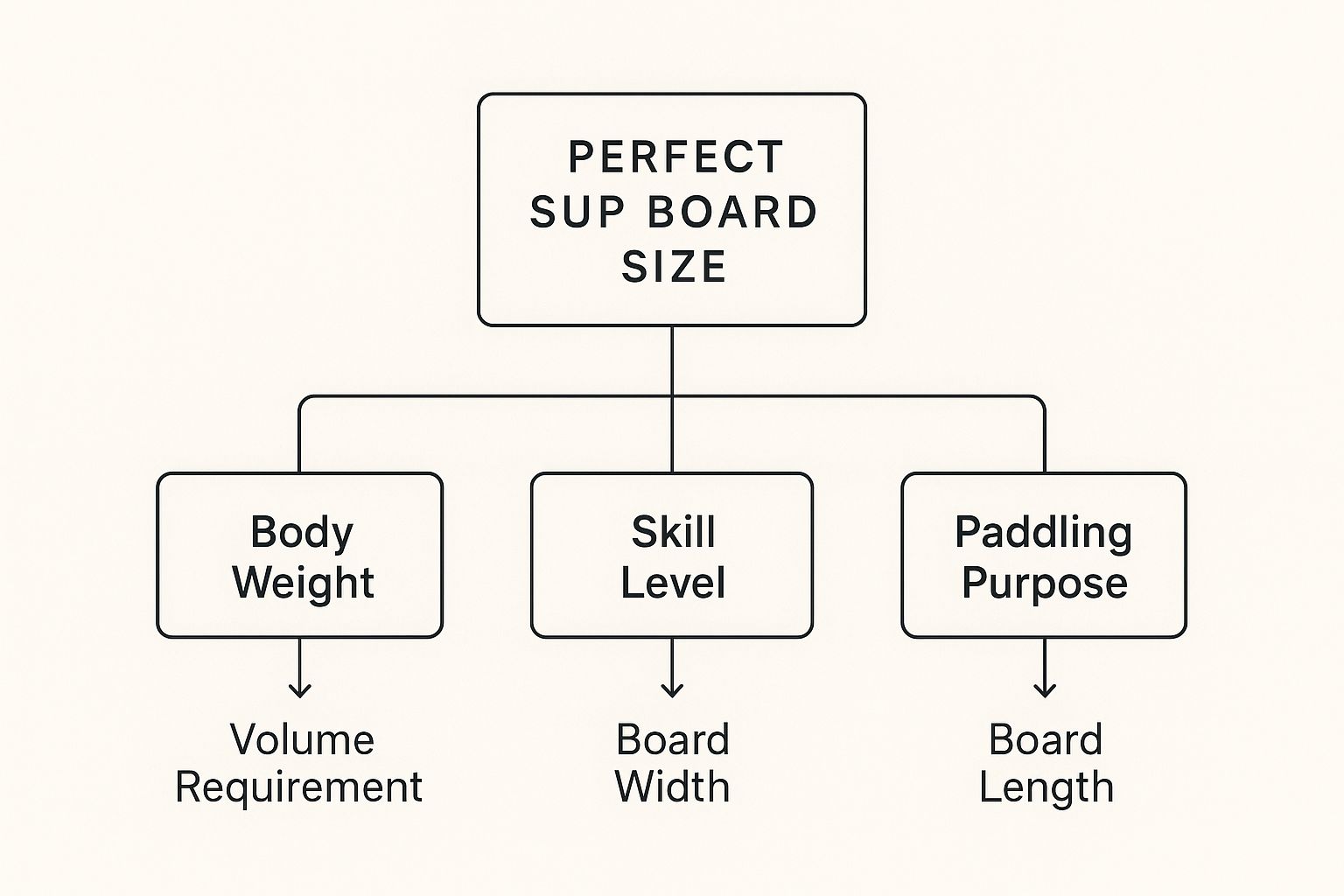
As you can see, your weight points you to the right volume, your skill level helps you decide on the width, and what you want to do with it defines the best length. It's a simple formula that works every time.
Understanding the Four Pillars of SUP Sizing
Figuring out the right size for a paddle board isn't about one magic number. It's actually a combination of four key ingredients working together. Think of them as the four pillars that hold up your entire experience on the water. Once you get your head around length, width, thickness, and volume, you can glance at any board's specs and know exactly how it’s going to feel.
Learning these four pillars is like learning the language of paddle boarding. It’s what takes you from being an unsure beginner to a paddler who can choose their next board with total confidence.
Length: The Trade-Off Between Speed and Agility
The first thing most people notice is the length, measured from the nose right to the tail. This dimension is the main decider when it comes to the board's speed and how easily it turns. Longer boards just glide better. They cut through the water and hold their line, meaning you can travel faster and straighter with less paddling.
That’s why they’re perfect for touring and covering serious distance. A sleek touring board, like a Loco motion touring SUP, might stretch out to 12'6" or even longer. They’re built to slice through the water on those long adventures.
On the other hand, shorter boards are way easier to whip around and feel much more responsive under your feet. A board designed purely for SUP surfing, for example, could be under 9'0", making it nimble enough to carve up a wave. For a bit of everything, boards between 10'0" and 11'0" strike a fantastic balance between glide and agility.
Width: Your Foundation for Stability and Confidence
Width, measured across the board’s widest point, is your best mate when it comes to stability. A wider board gives you a bigger, more solid platform, which makes balancing a whole lot easier. This is absolutely vital for beginners who are still getting their sea legs.
Most all-round boards, including our popular Loco Amigo, typically sit around 32 inches wide. This gives you plenty of stability for learning the ropes, casual paddling, and even things that demand extra balance, like a spot of SUP yoga.
As you get more comfortable, you might want to try a narrower board (30 inches or less) to pick up more speed, as less width means less drag. For most recreational paddlers, though, a width of 31 to 33 inches is the sweet spot for feeling confident and having a great time.
Thickness: The Key to Rigidity and How You Ride
A board’s thickness dictates how stiff it is and how high it sits in the water. This is especially important for inflatable paddle boards (iSUPs). A thicker board, usually 6 inches, will be much more rigid and won't sag under your weight, giving it a feel that's much closer to a solid hardboard.
That said, a 5-inch thick board can be incredibly stiff too, as long as it’s made with top-quality materials. It also has the advantage of putting you closer to the water, and this lower centre of gravity can actually improve your stability. At Loco, our inflatable range is all about premium construction to make sure you get maximum stiffness, no matter the thickness.
The thing to remember is that thickness is all about rigidity and buoyancy. A cheap, thin inflatable will feel like a bouncy castle, while a quality board will hold its shape and support you properly on the water.
Volume: Supporting Your Weight
Finally, let’s talk about volume – arguably the most critical number in any paddle board size guide. Measured in litres, volume tells you exactly how much weight a board can handle while staying afloat and stable. It's a bit like a boat's displacement; the more volume, the more weight it can happily float.
If your board’s volume is too low for your weight, it’ll sit deep in the water, feel incredibly wobbly, and be a real battle to paddle. That’s why matching the board’s volume to your weight is the absolute foundation of making a good choice. We dive deeper into this in our guide to boards for heavier riders.
How Your Weight and Skill Level Shape Your Choice
When it comes to picking the right paddle board, forget everything else for a moment and focus on one thing: your body weight. It's the single most important piece of the puzzle.
Think of a board's volume, measured in litres, as its lifting power or buoyancy. If there isn't enough volume to support you, the board will sit low in the water, feel sluggish, and become incredibly wobbly. It's a simple case of physics – get this wrong, and you'll spend more time in the water than on the board.
Picture two paddlers on a calm loch. One weighs 60kg and the other 90kg. For both to have the same stable, fun experience, the 90kg paddler needs a board with a whole lot more volume. A board that feels perfect for the lighter rider will feel like a tightrope for the heavier one.
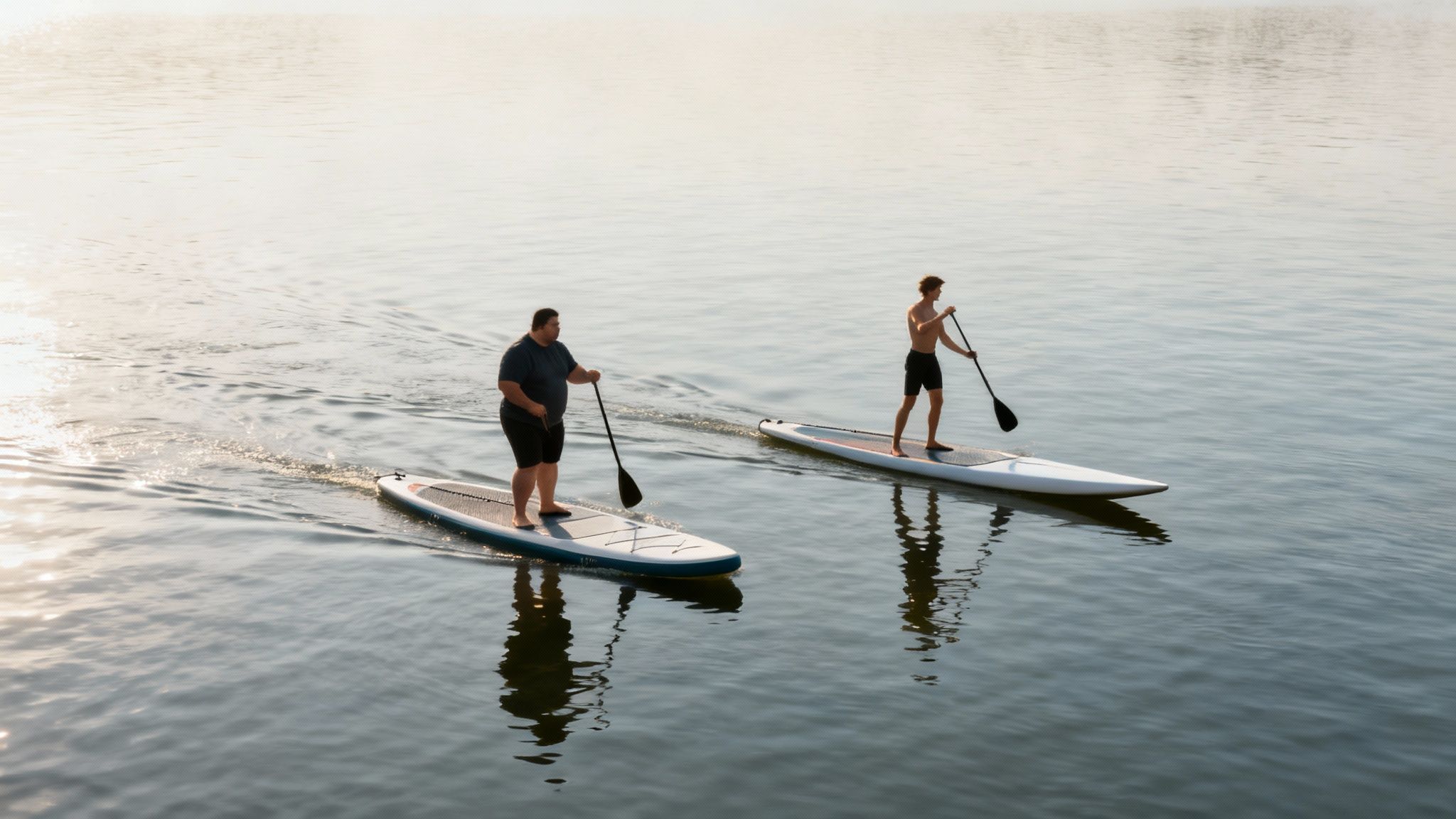
This is why being honest about your weight is non-negotiable. It’s the foundation for choosing a board that builds your confidence, rather than knocking it. For a more detailed look at this, we've put together a specialised SUP board guide for overweight riders.
Finding Your Ideal Board Volume
So, how do you find the right volume? Here's a simple rule of thumb for beginners: take your weight in kilograms and multiply it by two. The result is a great starting point for the volume you need in an all-round board.
For example, if you weigh 80kg, you should be looking for a board with around 160 litres of volume. This will give you plenty of stability to find your feet.
As you get better, the numbers change. An intermediate paddler might only need their weight multiplied by 1.7, and a real expert could go as low as 1.4. Why the drop? Experienced riders have honed their balance, allowing them to handle a more responsive, lower-volume board for better performance in the surf or during races.
The goal is to match volume not just to your current weight, but also to your skill level. A beginner needs that extra buoyancy for confidence, while an expert happily trades some stability for more speed and agility.
To make this even clearer, we've put together a handy table. Use it to find a solid starting point for the board volume that will suit you best.
Rider Weight and Skill vs Recommended Board Volume
| Rider Weight (kg) | Beginner Volume (Litres) | Intermediate Volume (Litres) | Advanced Volume (Litres) |
|---|---|---|---|
| 50-60 | 120-140 | 100-120 | 85-100 |
| 60-70 | 140-160 | 120-140 | 100-115 |
| 70-80 | 160-180 | 140-155 | 115-130 |
| 80-90 | 180-200 | 155-170 | 130-145 |
| 90-100 | 200-220 | 170-190 | 145-160 |
| 100+ | 220+ | 190+ | 160+ |
Remember, these are guidelines. If you're near the top of a weight range or plan to carry gear (or a dog!), it's always wise to size up to ensure you have enough stability.
How Skill Transforms the Equation
While your weight sets the baseline for volume, your skill level completely changes the kind of board you'll want. A beginner needs a wide, stable platform to feel secure and build confidence. That's why boards like our Loco Amigo 10'6", with its generous volume and forgiving 32" width, are perfect for mastering the basics.
An advanced paddler, on the other hand, might choose a board with a similar volume but a totally different shape. Their board could be much narrower and longer, designed purely for speed and glide. Their expert balance means they can handle the board's 'tippy' nature in exchange for that high-end performance.
Here in the UK, we've seen a huge demand for versatile, stable boards in the 10' to 11' range. This sweet spot perfectly matches the average weight of UK paddlers and the mixed bag of conditions we love to tackle—from glassy Scottish lochs to choppy Cornish coasts. It’s no surprise an all-rounder is often the smartest first board for anyone wanting to explore what the British Isles has to offer.
Matching Your Board to Your Paddling Style
So, we've covered how your weight and experience level point you towards the right volume and width. Now for the fun part: thinking about what you actually want to do on the water.
The board you'd choose for a lazy paddle down a quiet canal is a world away from one built to carve up waves in Cornwall. Your ambition on the water is the final piece of the puzzle, and it dictates the perfect length and shape for you.
Let's break down the most common types of paddling and see how specific board dimensions are tailored for each adventure.
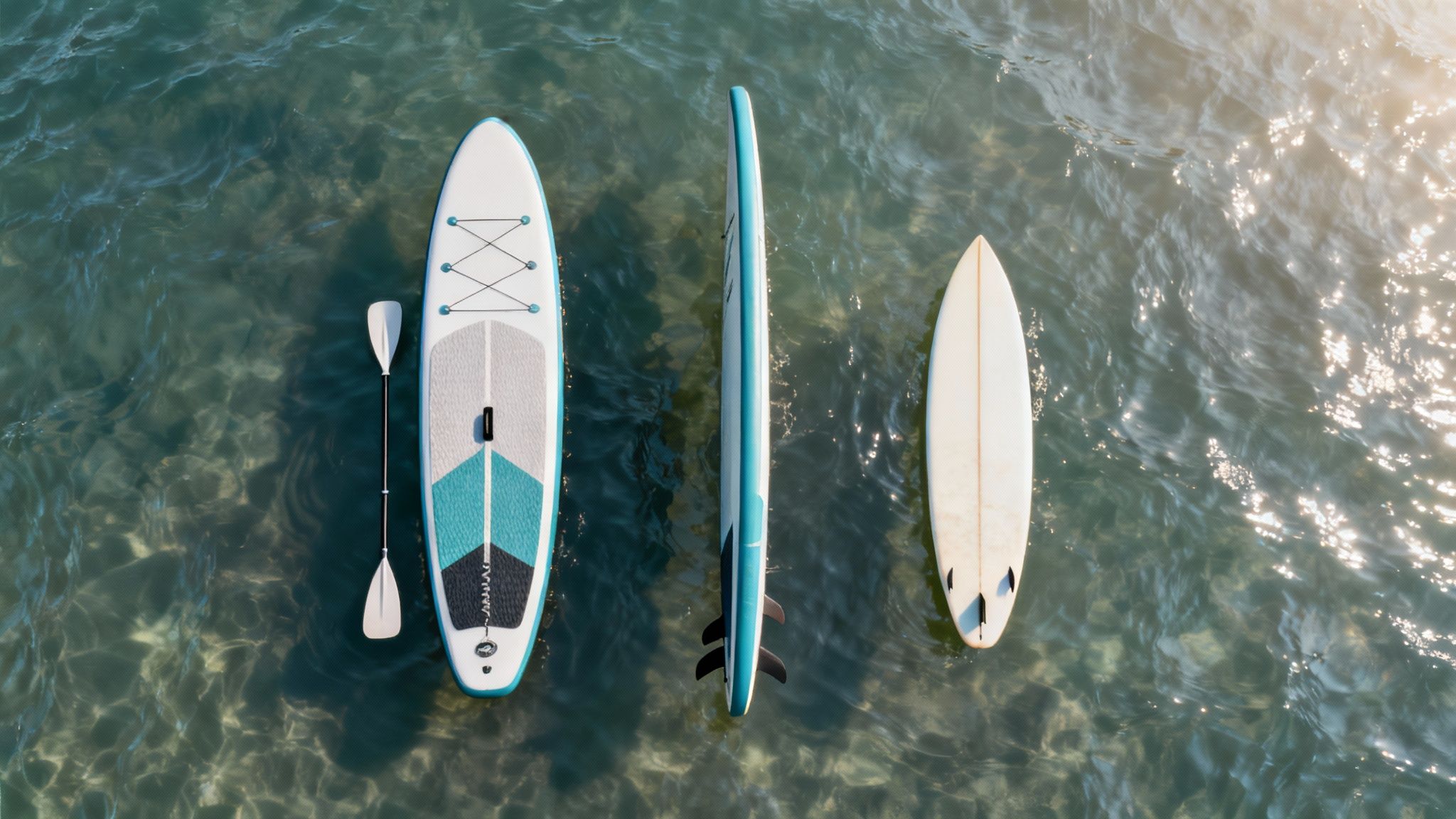
All-Around Versatility
Not sure where you'll be paddling? Want one board that can handle a bit of everything? An all-arounder is your best friend. Think of these as the Swiss Army knives of the paddleboarding world—stable, user-friendly, and happy on anything from flat water to small, rolling waves.
Our Loco Amigo range is a classic example. These boards usually sit between 10' and 10'8" long and are a comfortable 32" wide. That length gives you a nice mix of straight-line glide for exploring and enough responsiveness to have some fun. The generous width provides rock-solid stability, making it the perfect starting point for most newcomers and families.
Efficient Touring Boards
Do you have dreams of covering some serious distance, maybe exploring the coastline or gliding across the vastness of the Lake District? If that sounds like you, then a touring board is what you're after. These boards are built longer and often narrower than all-arounders, designed to slice through the water with far greater speed and efficiency.
- Length: Typically 11' to 12'6", sometimes even longer.
- Width: Often slimmed down to around 30" to minimise drag.
- Nose Shape: A pointed, displacing nose helps it cut through chop effortlessly.
This design means every single paddle stroke propels you further. A longer board also tracks straighter, so you'll waste less energy correcting your course and spend more time just enjoying the journey. If you're keen to dive deeper into this style, have a look at our complete guide to touring paddle boards.
Think of a touring board as a road bike, whereas an all-arounder is more like a mountain bike. It's purpose-built for speed and efficiency over long distances on smoother surfaces, making it the ultimate tool for dedicated explorers.
Responsive Surf SUPs
For the thrill-seekers who want to trade flat water for breaking waves, a specialised surf SUP isn't just a good idea—it's essential. These boards are a totally different animal: shorter, more curved in their outline, and with a much narrower tail. This aggressive shape is all about enabling the quick, sharp turns needed to carve on the face of a wave.
You'll find surf SUPs well under 9' long, which makes them incredibly nimble. While that short length would feel sluggish and wobbly trying to paddle in a straight line on a lake, on a wave, it translates into pure agility. It’s a perfect illustration of how board dimensions are dialled in for a very specific job.
High-Performance Racing Boards
At the very top end of the sport, you'll find racing boards. These are the Formula 1 cars of the paddleboarding world. They are incredibly long (often 14' or more) and exceptionally narrow, sometimes dipping to 24" or even less.
Every centimetre of their design is optimised for one thing: maximum speed. They're twitchy, challenging to balance on, and definitely not for beginners. But for competitive paddlers chasing a spot on the podium, there's simply no other choice.
Does Inflatable vs Hard Board Construction Affect Size?
One of the biggest questions new paddlers ask is whether to go for an inflatable stand-up paddle board (iSUP) or a traditional hard board. The great news is that the fundamental rules of sizing don't change. Length still dictates speed, width provides stability, and volume ensures you stay afloat, no matter what the board is made of.
That said, the material itself does shift your focus. While the core principles are the same, knowing the key differences between the two will help you make a much smarter choice.
Why Thickness is Crucial for Inflatables
When it comes to an inflatable board, thickness is the secret to rigidity. A thicker iSUP, pumped up to the right pressure (PSI), will feel firm and responsive under your feet, much like a hard board. This is precisely why high-quality inflatables, like those in the Loco air SUP range, are engineered to be incredibly stiff. It completely avoids that wobbly, "bouncy castle" sensation you often get with cheaper, less well-made models.
A top-notch iSUP can deliver performance that gives many hard boards a serious run for their money, but without the hassle of storage and transport. Honestly, this convenience is a massive part of why they've become so popular.
The Rise of the Inflatable Board
The sheer practicality of iSUPs has completely changed the face of paddle boarding here in the UK. Throughout the 2010s, inflatable boards just exploded in popularity, mainly because they were so convenient and manufacturers started offering sizes for every kind of paddler. By 2020, industry stats showed that over 75% of all paddle boards sold in the UK were inflatable. Most of these were all-rounders between 10 and 11 feet, making the sport accessible to almost everyone. You can dig deeper into the growth of the SUP market on coherentmarketinsights.com.
This incredible growth really boils down to a few simple, game-changing advantages:
- Easy Storage: An iSUP rolls up into a backpack. You can chuck it in the boot of your car or tuck it away in a cupboard at home. No garage or roof rack needed.
- Portability: You can take them on a plane, hike to a remote loch, or just carry one on your back down to the beach. The world is your oyster.
- Durability: Modern inflatables are built tough. They can handle bumps, scrapes, and being dropped in a way that would leave a composite hard board with a nasty ding.
For a full rundown on what to look for when you're buying, make sure to check out our detailed inflatable paddle board buyers' guide.
While iSUPs are fantastic all-rounders, a hard board's rigid construction still offers unmatched responsiveness. This direct connection to the water is why they remain the top choice for high-performance activities like competitive surfing and racing.
In the end, it all comes down to what you prioritise. If you value convenience, durability, and versatility above everything else, an inflatable is almost certainly your perfect match. But if you're chasing that extra ounce of performance for racing or surfing, then a hard board might just be the one for you.
Still Unsure? Common Questions on Paddle Board Sizing
Even after digging into the details, you might have a couple of lingering questions. That's completely normal. Choosing a board is a big decision, and it’s smart to be thorough. Let’s tackle some of the most common dilemmas paddlers face to get you over the finish line with total confidence.
I’m Stuck Between Two Board Sizes, What Should I Do?
This is a classic head-scratcher, but the answer is nearly always the same: size up.
Think of it this way: a slightly larger board is your best friend when you're finding your feet. It offers more stability and versatility, which is worth its weight in gold. That little bit of extra volume acts as a safety net, making you feel far more secure if the wind picks up or the water gets a bit choppy.
Sizing up also future-proofs your board. Want to bring the dog along? No problem. Fancy a day trip with a dry bag full of gear? A bigger board handles the extra weight with ease. While a smaller board might feel a fraction more nimble, the confidence and adaptability you get from sizing up is a much better trade-off in the long run.
Practical Example: Let's say you're a 75kg paddler eyeing up the Loco Amigo and can't decide between the 10' and the 10'6". The 10'6" is the smarter choice. It'll give you a more dependable and enjoyable platform, especially on those days when conditions aren't perfectly glassy.
Does My Height Matter When Choosing a Board?
While weight is definitely the main event for figuring out volume, your height does have a say in the matter. It all comes down to your centre of gravity.
Taller riders—we’re talking over 6'2" or 188cm—naturally have a higher centre of gravity. This can make a narrower board feel a bit like you’re walking a tightrope.
If that sounds like you, it’s a good idea to look for a board that’s a touch wider than the standard recommendation for your weight. Aiming for something 32 inches or wider will create a much more solid base under your feet. That extra width can make a world of difference to your confidence, especially when you’re paddling in less-than-perfect conditions. For most riders, though, matching the board's volume to your weight is still the number one priority.
Can One Board Really Work for Both Yoga and Touring?
Absolutely! This is precisely where a top-notch all-around board proves its worth. These boards are the Swiss Army knives of the SUP world, designed from the ground up to be versatile.
A board like the Loco Amigo 10'6" is the perfect example. It has a generous width (usually 32 inches) and a comfortable, full-length deck pad, which creates the stable platform you need to nail those yoga poses. But its streamlined shape and length also give it enough glide to make touring on lakes, canals, and calm coastal waters a real pleasure.
Sure, a specialised race board will be faster and a dedicated yoga board might be a bit more stable, but a brilliant all-arounder is the ideal compromise if you want to do a bit of everything without needing a garage full of gear.
What Happens If My Paddle Board Is Too Small?
Paddling a board that’s too small for you is one of the quickest ways to ruin a day on the water. It’s a classic beginner mistake, and it's incredibly frustrating.
Without enough volume to properly support your weight, the board will sit way too low in the water. This makes it feel unbelievably wobbly and nearly impossible to paddle in a straight line.
An undersized board will feel unstable and inefficient. You'll likely find the nose constantly dipping under the water as you paddle, and you'll burn all your energy just trying to stay balanced instead of actually enjoying the ride.
Honestly, it’s enough to make anyone want to give up. That’s why following a reliable paddle board size guide and being honest about your weight and skill level is so critical. It’s the key to making sure your SUP journey gets off to the best possible start.
Ready to find the board that’s perfectly sized for your next adventure? At Loco Surfing, we have over 18 years of experience crafting high-performance boards for every type of paddler. Explore our full range of inflatable and hard SUPs today.


